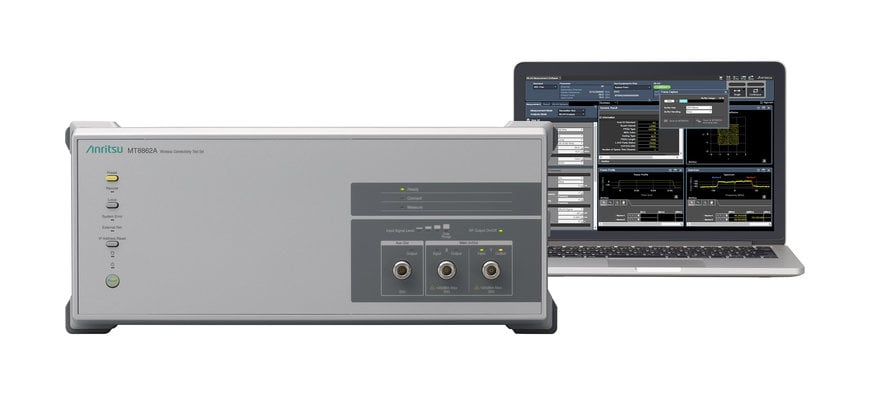electronics-journal.com
23
'21
Written on Modified on
Evaluating New IEEE 802.11ax 6-GHz Band WLAN Performance using Network Mode
All-in-one MT8862A supports Network-Mode measurements of 6-GHz band WLAN equipment with 160-MHz wide channels.

Anritsu Corporation (President Hirokazu Hamada) is pleased to announce the June-16 launch of its new option to extend the functions of the company’s Wireless Connectivity Test Set MT8862A by supporting evaluation of IEEE 802.11ax*1 6-GHz band WLAN TRX characteristics.
Following FCC approval in April 2020 for unlicensed use of the 6-GHz operation band as the first new WLAN frequency band in almost 20 years, countries worldwide are starting device testing and deployment. The IEEE 802.11ax WLAN standard regulates this 6-GHz band and the Wi-Fi Alliance is starting its Wi-Fi 6E certification program for IEEE 802.11ax 6-GHz devices.
The MT8862A is designed to evaluate RF TRX performance of IEEE 802.11a/b/g/n/ac/ax WLAN devices. Additionally, as well as implementing all-in-one 2.4, 5, and 6-GHz band RF TRX measurements, the MT8862A also supports performance evaluations defined by IEEE 802.11 standards and Over-The-Air (OTA) performance tests defined by both CTIA*2 and the Wi-Fi Alliance.
By using this option, the MT8862A can evaluate the RF characteristics of IEEE 802.11ax 6-GHz devices using either the Network Mode*3 or Direct Mode*4. In addition to shorter evaluation time using the Direct Mode, the Network Mode facilitates evaluation under actual operation conditions using signaling messages*5.
While developing this 6-GHz band option, Anritsu also added support for 160-MHz wide channels. Since the 6-GHz band covers a 1200-MHz wide operation band, use of 160-MHz wide channels becomes practical, which is expected to facilitate streaming of higher-definition video and larger-capacity data than previously possible.
By supporting measurement and testing of 6-GHz band WLAN devices and 160-MHz wide channels, Anritsu expects its MT8862A to play a key role in development of next-generation communications devices.
Development Background
Along with the spread of IoT devices, WLAN functions are being built increasingly into more mobile products, such as tablet PCs and smartphones, as well as into home electronics, including printers and TVs, automobiles, industrial machines, sensing equipment, etc.
On the other hand, communications environments with a high density of WLAN devices are suffering from a shortage of communications resources for WLAN connections, resulting in challenges such as slower communications speeds and unstable connections.
Solving these many challenges, especially the shortage of communications resources, by using the 6-GHz band will help drive development of novel applications to promote leading-edge industrial development, which in turn, increases the urgent need for measuring instruments supporting evaluation of the RF TRX characteristics of IEEE 802.11ax 6-GHz band devices.
Anritsu has developed this option to extend the MT8862A functions by supporting performance evaluation of IEEE 802.11ax 6-GHz band devices.
Technical Terms
*1 IEEE 802.11ax - One WLAN standard defined by the Institute of Electrical and Electronics Engineers (IEEE) supporting ultra-high speeds up to a theoretical maximum of 9.61 Gbps.
*2 CTIA - Abbreviation for Cellular Telecommunications & Internet Association—a nonprofit international organization composed of wireless and related operators, manufacturers, and service providers.
*3 Network Mode - Also called Signaling Mode–a mode for measurement under actual operation conditions using signaling messages.
*4 Direct Mode - Also called Test Mode—a measurement mode for testing by controlling devices using special commands and requiring a physical connection using a command line.
*5 Signaling Message - Communications data defining procedure and control for connecting with device; can be used to capture information, such as device communications bandwidth and encoding method.
www.anritsu.com

